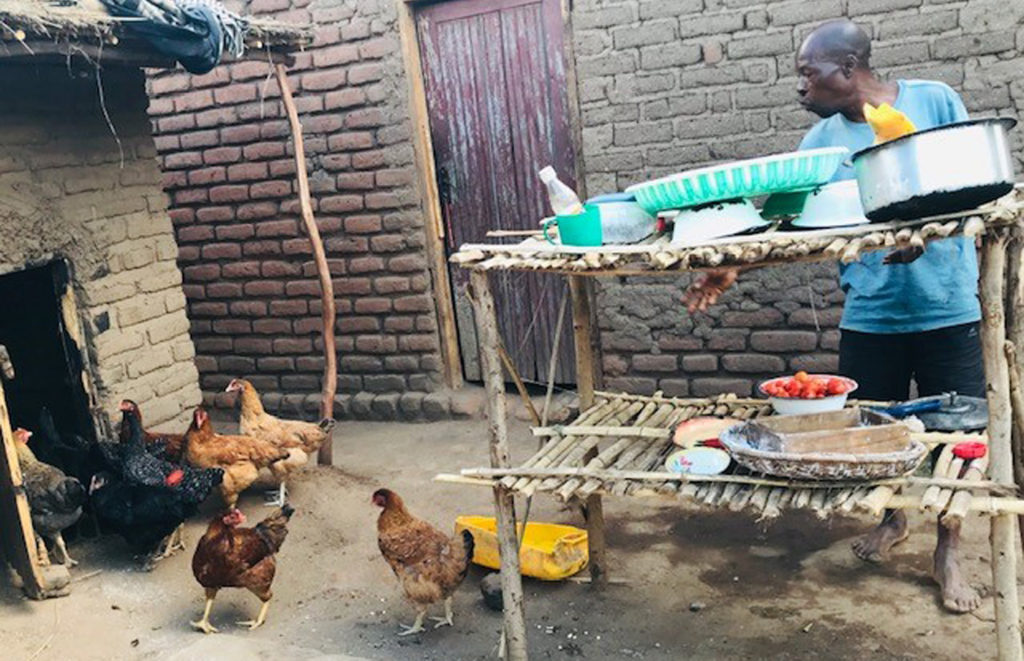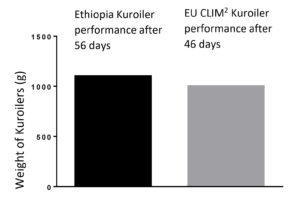
Kuroiler chickens are part of the family in this rural homestead in Chiradzulu District. Photo: Sabine Homann-Kee Tui, ICRISAT
When the Kuroiler, a dual-purpose chicken breed renowned for its performance under free range village farming systems was introduced in Malawi by the CLIM2 project, it presented an opportunity for smallholder farmers to tap into the increasing urban demand for village chickens.
“The Kuroiler hens came two weeks ago. They were only 12 weeks old and were large in body size like our mature local chickens,” explains Mrs Falida Chitera from Mikundi Club, Thumbwe EPA in Chiradzulu district. “I am happy to be raising these birds for income and they can also improve nutrition in the household,” she adds.
Mwaiwathu and Mikundi clubs are part of the eight farmer groups within CLIM2 project areas who received Kuroiler birds for evaluation under local management practices. Farmers from both groups are unanimous in wanting eggs from their Kuroiler chickens to provide good nutrition to those in the community.
Why the Kuroiler breed?
The project’s decision to test the Kuroiler bird for its suitability within Malawian communities arose when they examined Malawi’s poultry subsector. Poultry plays a critically important role in improving the nutrition and livelihoods of resource-poor farmers in Malawi (Benfica and Thurlow, 2017). Eggs and poultry meat contribute to human nutrition and health, especially in the early years of a child’s life, and more so where diets are poor and lack diversity (Grace et al. 2018).
In Southern Malawi, about every second family owns a few chickens (Homann-Kee Tui et al. 2018). Women manage the chickens and can generate substantial family income where alternative options are limited. The village chickens are adapted to the local environment and live on scavenging. Their performance is, however, low in terms of meat and egg production, and hence nutritional benefits and income that can be generated are also low. At the same time, more and more urban consumers are appreciating them to be healthier (free of antibiotics and hormones) and tasty, and they are willing to pay a higher price for them (5000 MK live weight price for a village chicken versus 3000 MK for a broiler). This led to ascertaining what breed would respond to farmers’ needs for income and nutrition, and that could be bred by farmers using own locally available resources.
Over the past 50 years, the Government of Malawi has been promoting exotic chicken breeds. Among the officially recognized breeds are the village chickens, Cobb and Ross strains, Black Australops, Hylines and Indian river. However, questions arose on the type of improved chicken breed that would do well under smallholder farming systems and farmers’ willingness to improve management conditions as well. And how would the chickens respond to new conditions?
CLIM2 identified the Kuroiler, a dual-purpose chicken, for its renowned performance under free range village farming systems in other countries. The breed almost doubles its body weight and produces about five times more eggs compared to village chickens. Good conversion of local feeds implies that farmers can save on feed costs, using their own locally produced feed. Moreover, Kuroilers are a better alternative since they survive better under smallholder farmer management conditions than exotic breeds, are cost-effective in terms of on-farm production with high economic and nutritional returns.
Kuroilers land in Malawi
The project teamed up with the government of Malawi to introduce the breed to Malawi, and to test and evaluate it under smallholder farming and marketing conditions. Officials traveled to Tanzania to adapt the model being used to produce and distribute Kuroiler birds. The team engaged AKM Glitters Ltd, certified keepers of Kuroiler parent stock, to source the breed and for long term business support to farmers in Malawi. To evaluate its suitability to local farming systems, the project combined on-station and on-farm evaluations, under smallholder farmer conditions and in a company set up.
On 27 February 2019, 5000 day-old Kuroiler chicks landed in Blantyre. A thousand chicks were delivered to the government research farm at the Department for Animal Health and Production Station, Mikolongwe for on-station evaluation. Four thousand chicks were quarantined at a farm near Blantyre which the project had refurbished to grow the chicks for about 10 weeks; 1000 female chickens were then handed over to individual smallholder farmers and the remaining female chickens were to be managed by two farmer groups that had registered as a business company.
Evaluation at Mikolongwe Research Station: The Kuroiler birds showed desirable growth characteristics during their six-week quarantine. With an average feed intake of 67 g per day in the first six weeks, double weight gain and an average weight of 1000 g at six weeks, the birds have the potential to offer more meat in less time compared to available breeds. The Kuroiler has high feed conversion efficiency, adding more weight with less amount of feed. It showed better performance relative to the Black Australorp, and was on par with the extensive performance trials conducted under the Bill & Melinda Gates Foundation project promoting Kuroilers in Ethiopia.
 Evaluation at Lunzu quarantine station: At the Lunzu quarantine station, with management conditions between the highly specialized management at Mikolongwe research station and farmer management, the Kuroilers compared favourably with results obtained from performance trials on-farm in the BMGF project in Ethiopia.
Evaluation at Lunzu quarantine station: At the Lunzu quarantine station, with management conditions between the highly specialized management at Mikolongwe research station and farmer management, the Kuroilers compared favourably with results obtained from performance trials on-farm in the BMGF project in Ethiopia.
The Department of Animal Health and Livestock Development tested the birds’ performance at the research station and quarantine farm in terms of survivability, weight gain, bio-security adherence and management recommendations.
 Evaluation of Kuroiler female chickens under smallholder farmer conditions: Starting the twelfth week, the Kuroilers were evaluated under village farming conditions. Eighty farmers each received 10 pullets and 30 other farmers received 100 Kuroilers to test them under semi-intensive management. To qualify to receive chickens, a farmer needed to be a member of a poultry farmer group, have experience in raising chickens, and been trained in poultry management and the construction of a chicken house. The farmers were instructed not to separate the Kuroilers from the local birds. As a preventive measure, all village birds were vaccinated against Newcastle disease. The birds were evaluated for growth, survival and productivity during a period of 48 weeks.
Evaluation of Kuroiler female chickens under smallholder farmer conditions: Starting the twelfth week, the Kuroilers were evaluated under village farming conditions. Eighty farmers each received 10 pullets and 30 other farmers received 100 Kuroilers to test them under semi-intensive management. To qualify to receive chickens, a farmer needed to be a member of a poultry farmer group, have experience in raising chickens, and been trained in poultry management and the construction of a chicken house. The farmers were instructed not to separate the Kuroilers from the local birds. As a preventive measure, all village birds were vaccinated against Newcastle disease. The birds were evaluated for growth, survival and productivity during a period of 48 weeks.
The business model for chicken companies: A step ahead to commercialization, two farmer groups — Chimtengo youth company with seven members in Chiradzulu and Namagazi chicken producers with 30 members in Thyolo — were registered as poultry companies. Following a qualifying training on preparing a business plan, they developed their own business plans with details on production, management and marketing. The birds were handed over to the companies, while still being kept at the farm at Lunzu. The companies through shares in the business, maintained the chicken under well fed and safe conditions, and select members attended the farm for training, while the birds were being further evaluated for economic sustainability.
Conclusions and recommendations
- Cost-effective feeding: Special feed ratios using locally available materials were developed to cut costs and reduce dependence on commercial stockfeeds. The chickens have responded well to this.
- Survivability: There was an impressive mortality rate of below 3% in the flock received by the villagers, given the recent mortality from Newcastle disease in the same areas.
- Community-based health care: Regular village-level vaccinations are critical to ensure a successful chicken business. While disease prevention is a government mandate, the coordination links farmers in joint action.
- Marketability: Farmers were confident of selling the chicken in nearby rural markets; options to link to government preferential procurement arrangements are being explored.
- Business company development: Establishing a business company is new to smallholder farmers; hence facilitating positive group dynamics is important for success in this area.

Children fascinated by Kuroiler chickens at a rural homestead in Chiradzulu District.
Photo: Claire Mawandi
References
Benfica, R. and Thurlow, J. (2017) Identifying investment priorities for Malawian agriculture. Presentation to the Ministry of Agriculture, Irrigation and Water Development. Lilongwe, February 2017. https://pim.cgiar.org/files/2017/04/IFPRI-IFAD-PIM-Malawi-Presentation.pdf
Grace, D., Dominguez-Salas, P., Alonso, S., Lannerstad, M., Muunda, E., Ngwili, N., Omar, A., Khan, M. and Otobo, E. 2018. The influence of livestock-derived foods on nutrition during the first 1,000 days of life. ILRI Policy Brief 25. Nairobi, Kenya: ILRI.
Homann-Kee Tui, S., Mausch, K. Sunday, K. (2017). Improved livelihoods through sustainable intensification and diversification of market oriented crop-livestock systems in southern Malawi. Baseline Report. ICRISAT.
About CLIM2
The project on Improved livelihoods through sustainable intensification and diversification of market oriented crop-livestock systems in southern Malawi (CLIM2) is working to strengthen diversification and integration in crop-livestock farming systems in three districts of Malawi. The project is funded by the European Union under the Farm Income Diversification Programme (FIDP) Phase II – Agribusiness. The project is implemented by the International Crops Research Institute for the Semi-Arid Tropics (ICRISAT) as the lead agency, in collaboration with the International Livestock Research Institute (ILRI) and Small-Scale Livestock and Livelihoods Programme (SSLLP); and several departments within the Malawi Ministry of Agriculture, Irrigation and Water Development.
About the Author:

Claire Mwamadi,
Monitoring and Evaluation Officer, Small-Scale Livestock and Livelihoods Programme


Add Comment